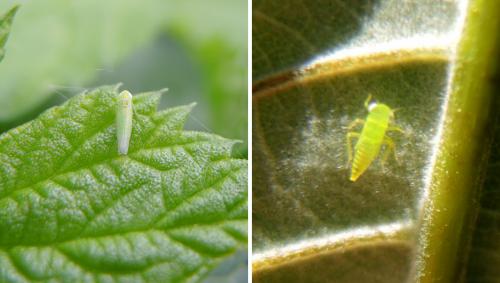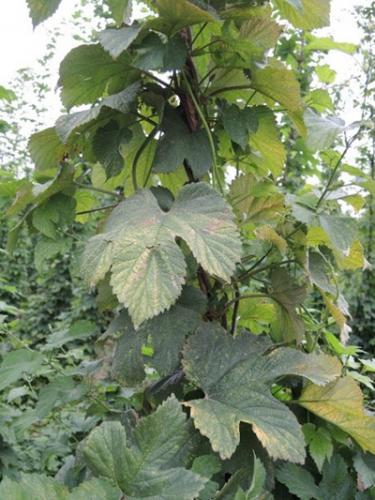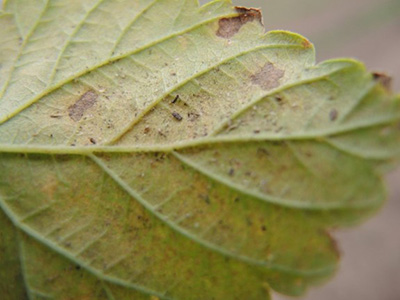Michigan hop scouting report – June 22, 2017
Potato leafhopper and twospotted spider mite populations are increasing, requiring treatment in some locations.

Hop growers around the region have been working hard to accurately determine water needs with dry conditions in some locations and heavy and consistent rainfall in other areas. Overall, the weed control looks great for this point in the season.
Potato leafhopper and mite populations are at levels warranting treatments on some farms. Rose chafer activity is beginning to wane in some locations. Conditions are favorable for downy mildew and powdery mildew infections.
Potato leafhopper
Potato leafhopper populations have built to damaging levels in many hopyards. Like many plants, hops are sensitive to the saliva of potato leafhopper, which is injected by the insect while feeding. Damage to leaf tissue can cause reduced photosynthesis, which can impact production, quality and cause death in first year plants.
Most injury occurs on rapidly expanding leaf tissue with potato leafhopper feeding near the edges of the leaves using piercing-sucking mouthparts. Symptoms of feeding appear as whitish dots arranged in triangular shapes near the edges. Heavily damaged leaves are cupped with necrotic and chlorotic edges and eventually fall from the tree. Severely infested shoots produce small, bunched leaves with reduced photosynthetic capacity. Symptoms of feeding damage are commonly referred to as “hopper burn.”
Adult leafhoppers are pale to bright green and about 0.125 inch long. Adults are easily noticeable, jumping, flying or running when agitated. The nymphs (immature leafhoppers) are smaller, pale green and have no wings, but are very similar in form to the adults. The potato leafhopper can’t survive Michigan’s winter and survives in the Gulf States until adults migrate north in the spring on weather systems. Economic thresholds have not been developed for potato leafhopper in hop.

Light green potato leafhopper adult and bright green immature nymph. Photos by Erin Lizotte, MSU Extension.
Scouting should be performed weekly as soon as leaf tissue is present to ensure detection early and prevent injury. More frequent spot checks should be done following rain storms that carry the first populations north and can be the source of new infestations all season. Scouting should be performed at least weekly.
The easiest way to observe potato leafhopper is by flipping the shoots or leaves over and looking for adults and nymphs on the underside of leaves. Pay special attention to succulent new leaves on the terminals of branches.
The most common classes of insecticides recommended for control of potato leafhopper include the pyrethroids, neonicotinoids and organophosphates. Organophosphates are broad spectrum and can disrupt natural enemies; they should only be used when necessary to rotate insecticidal mode of action or to target another pest at the same time. Pyrethroids are also effective at controlling potato leafhopper and remain relatively inexpensive.
However, pyrethroids have been shown to cause increases in mite populations in other crops and should be used judiciously, particularly early in the season when mite populations have time to build over the season. Neonicotinoids are longer lasting and narrow spectrum making them a solid choice for management. For more information on chemical management, refer to the Michigan State University Extension bulletin “Michigan Hop Management Guide.”
Downey mildew
Growers should continue applying fungicide treatments on a protectant basis for downy mildew on a seven- to 10-day reapplication interval until harvest. The time between applications may stretch longer when the weather is dry and if hopyards don’t have active infections.
Several periods in the season are particularly critical for disease control. The periods are immediately before and after training, when lateral branches begin to develop, bloom and cone development. Covering young, developing bracts before cones close up is critical to protecting against downy mildew when conditions for disease are favorable. Ensuring adequate coverage on undersides of bracts, where infection occurs, becomes increasingly difficult as cones mature.
There are a number of effective fungicides registered for downy mildew control on hop in Michigan including Curzate, Forum, Revus, Zampro and Ranman. For a complete list of registered products please refer to the MSU Extension bulletin “Michigan Hop Management Guide, 2017.” Presidio is not available for use by Michigan growers this season.
Organic growers have fewer options and will need to focus on keeping tissue protected, selecting downy mildew-tolerant varieties and following cultural practices to limit downy mildew infection. Copper-based products are the mainstay of downy mildew management in organic hopyards and offer five to seven days of protection, but no post-infection activity.
Products containing copper hydroxide have been shown to provide superior disease control in other cropping systems.The pre-harvest intervals for copper formulations vary, so refer to the label.
Actinovate, Eco-mate, Armicarb-O and Sonata are additional products that list downy mildew on the label and are approved for organic use in hops. The pre-harvest interval for these products are one day or less. We have no data on the efficacy of these products.
Growers will need to use additional fungicide applications to treat for powdery mildew, which has been found in Michigan this season, likely due to conducive weather conditions. Read more about identifying and treating powdery mildew of hop.
Twospotted spider mite
Twospotted spider mite populations are visible at some locations, though heavy rains in some regions seem to be slowing development this season. Mites are most effectively managed while still at low population levels, so scout carefully for mites season-long, starting before damage becomes visible.

Symptoms of twospotted spider mite damage on hop. Photo by Erin Lizotte, MSU Extension.
Twospotted spider mite thrive under hot conditions, with the pace of development increasing until an upper threshold around 100 degrees Fahrenheit is reached. Conversely, cold and wet weather is not conducive to development. Twospotted spider mite are very small but can be observed on the underside of leaves using a hand lens. Look for movement to help locate the mites.

Underside of infested leaf with webbing and dusty appearance. Photo credit Erin Lizotte, MSU Extension.
The eggs look like tiny, clear spheres and are most commonly found in close proximity to adults, webbing, cast skins and larvae. The larvae are small, translucent versions of the adults. Adults and some larval stages also have two distinct dark spots for which they are named.
When you are scouting, keep an eye out for beneficial, predatory mites that actually feed on twospotted spider mite. Predatory mites are often translucent, smaller than twospotted spider mite and move at a faster speed across the leaf surface. Predatory mites play an important role in balancing the twospotted spider mite population and should be protected when possible.

Two spotted spider mite adults, larvae and eggs under magnification. Photo by David Cappaert, Bugwood.org.
Scout for mites season long and make applications only when needed and as recommended by the miticide manufacturer. Some miticides are better positioned early in the season when mite levels are low; others are more effective in situations with high mite populations. Use a hand lens to evaluate two leaves from 20 plants per yard.
Avoid applying pyrethroids insecticides if treating for mites, which are hard on beneficial mites and have been shown to flare pest mite populations in hop. The table below lists miticide treatment options for producers in Michigan.
| Miticide options to control two-spotted spider mite in hop. | ||||||
|---|---|---|---|---|---|---|
| Compound (IRAC Code) | Active ingredient | Affected stage | Considerations | Residual control1 | Preharvest interval | Impact on predatory mites2 |
| Savey (10A) | hexythiazox | Egg/larvae | Apply before burr formation and before adult build up. Savey will not control adults. Use higher rate for moderate to heavy mite pressure, for large plants or longer residual control. | 6-12 weeks | 0d | 1 |
|
Agri-Mek |
abamectin | Motiles* | Apply at threshold and with required adjuvant. Application rate is based on bine height. | 6-12 weeks | 28d | 3 |
| Zeal (10B) | etoxazole | Egg/larvae | For best results apply when mite populations are low, at or prior to threshold. | 6-10 weeks | 7d | 2 |
| Envidor (23) | spirodiclofen | Egg, motiles* | For best results, apply early in the infestation before threshold as soon mite activity begins. Low rates are adequate if plants are small and pressure is low. Use higher rate for moderate to heavy mite pressure, on large plants or for longer residual control. | 6-10 weeks | 17d | 2 |
| Portal or Fujimite (21) | fenpyroximate | Motiles* | For best results, apply before mite populations exceed 5 mites/leaf. Not recommended when temperature exceed 90F. | 6-8 weeks | Portal 15d, Fujimite 14d | 1 |
| Acramite (20D) | bifenazate | Motiles* | Provides quick knockdown, good coverage is key. Best positioned as soon as mites become active. Use low rates at early infestation and increased rates under higher mite pressure. | 6-8 weeks | 14d | 1 |
| Magister SC (21) | fenazaquin | Motiles* | Provides quick knowdown. Has some activity against powdery mildew. One application per year. | 3-5 weeks | 7d | ** |
*Motile forms include mite larvae, nymph and adult stages.
** Harmless on most beneficials, but has moderate toxicity on honey bees and phytoseiid predacious mites.
1. Residual control is based on studies in tree fruit and is highly dependent on rate, coverage, weather and mite pressure at the time of application.
2. Rankings represent relative toxicity based on mortality data from studies conducted in tree fruit, hop, mint and grape following direct exposure. 1 = <30 percent mortality; 2 = 30-79 percent mortality; 3 = 79-99 percent mortality; and 4 = >99 percent mortality.
Modified from a table by John Wise, Larry Gut and Rufus Isaacs, Michigan State University, 2015.
Future pests of concern
Looking ahead, scout for the arrival of Japanese beetle as early as next week (beginning June 26) with degree-day accumulations ahead of average this season and driving insect development. Also, keep an eye out for twospotted spider mites, as populations will likely rise with drier weather and higher temperatures.
Information presented here does not supersede the label directions. To protect yourself, others and the environment, always read the label before applying any pesticide.
This material is based upon work supported by the National Institute of Food and Agriculture, U.S. Department of Agriculture, under Agreement No. 2015-09785. Any opinions, findings, conclusions, or recommendations expressed in this publication are those of the author(s) and do not necessarily reflect the view of the U.S. Department of Agriculture.



 Print
Print Email
Email


